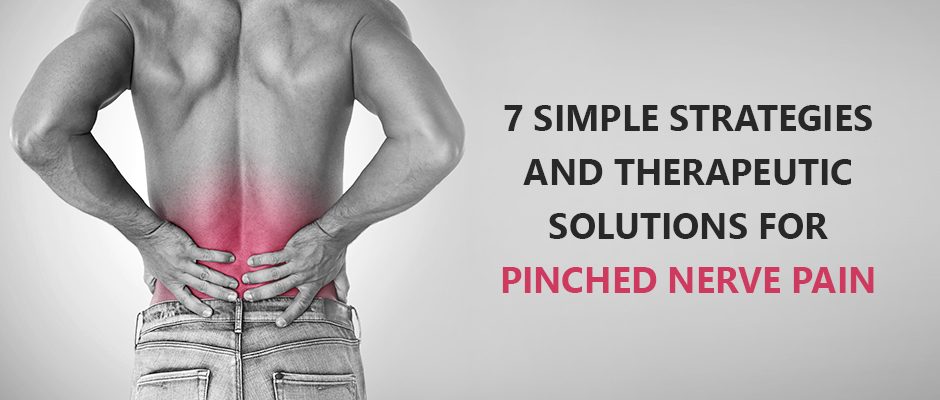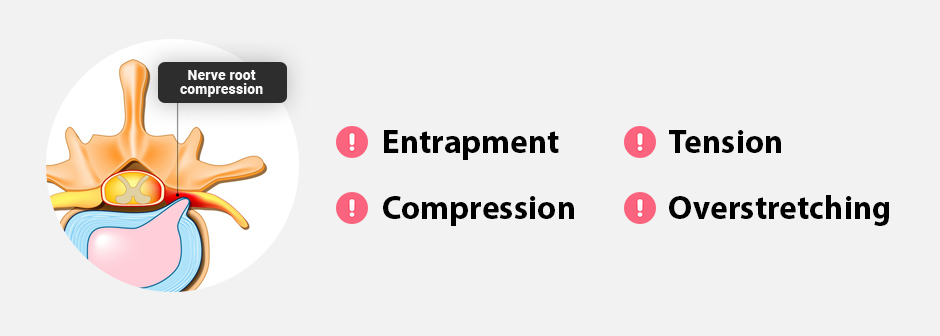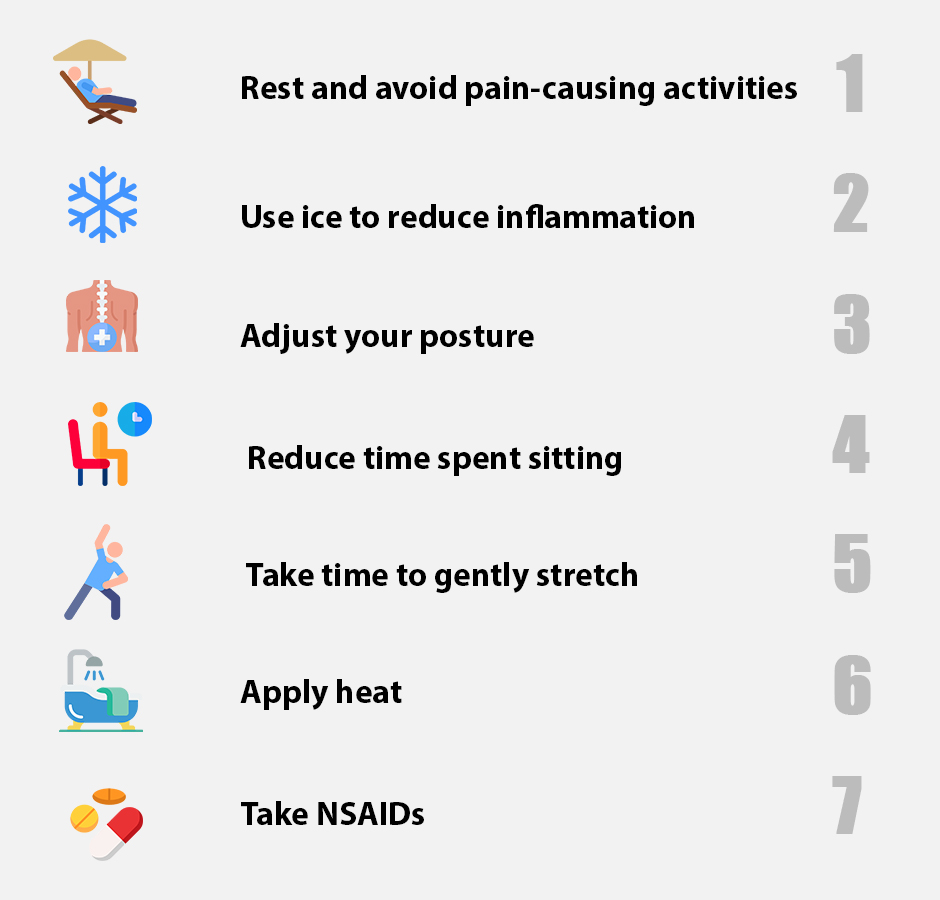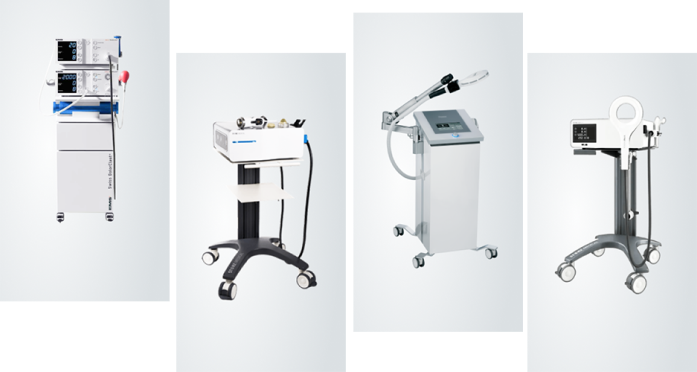The human body is designed to move, but modern lifestyles keep us in sedentary mode for hours on end, day after day. Sitting for long hours takes a toll on your body in myriad ways. Not only does it impact your cardiorespiratory health, but it also rearranges your body alignment by creating muscle imbalances that put extra stress on your joints and connective tissues. When your body’s architecture becomes misaligned, your nerves can become compressed or entrapped, restricting their ability to glide freely.
Learn about what causes pinched nerves, seven self-help strategies for relieving pinched-nerve pain, and some therapeutic solutions for eliminating pinched nerves and restoring pain-free gliding.
“Pinched nerve” is actually a non-clinical umbrella term that does not really explain the underlying cause of nerve afflictions. Your peripheral nerves travel throughout your body in specialized fascial tunnels created by spaces between muscles. On their path along these tunnels, they sometimes encounter osteofibrous tunnels, aponeurotic bridges and blood vessels. Nerves also sometimes dive inside muscles without the protection of fascia.
There are multiple causes of mechanical nerve dysfunction:
- Entrapment
- Compression
- Tension
- Overstretching
Every nerve has its own unique anatomical pathway, and nerve compressions are unique to the individual patient’s anatomy and their movement patterns.
Factors that contribute to the risk of pinched nerves include:
- Everyday stress
- Sedentary lifestyle and excess sitting
- Poor sleeping posture
- Suboptimal posture while sitting or standing
- Scar tissue and adhesions from trauma
- Muscle overuse from work or exercise
- Inefficient lifting technique
- Aggressive stretching
- Excess body weight
- Being out of shape
It is important to note that failure to treat a pinched nerve can cause serious nerve damage over time that could become irreversible. If pinched nerve pain persists after gentle self-treatment, you should seek the help of a therapist trained in diagnostic ultrasonography. Ultrasound imaging lets you visualize the nerves in motion, in real time. It can reveal entrapments and pressure points that can be resolved with physical therapy.
If you think your pain is caused by a pinched nerve, there are some things you can do right away to relieve pressure and reduce pain.
- Rest and avoid pain-causing activities: Lying down can help reduce the stress load on your muscles and joints, giving nerves a break from pressure. Temporarily avoid activities like sports or heavy lifting that put pressure on nerves.
- Use ice to reduce inflammation. A herniated and inflamed vertebral disc can put pressure on the nerve root, causing pain. Apply a bag of frozen vegetables or an ice pack directly on the painful site for 15-minute intervals throughout the day, to numb pain and reduce inflammation.
- Adjust your posture. Try to be aware of your body alignment throughout the day, and make periodic adjustments to relieve pressure on nerves. Be especially aware of your head and neck position when using electronic devices, and avoid a head-forward posture. Try placing a pillow between your knees while sleeping to better align your spine.
- Reduce time spent sitting. Sitting for long hours on end can weaken the muscles that support your spine, setting you up for nerve pain. Try standing at your workstation, and take frequent activity breaks. When relaxing at home, try sitting on the floor instead of slouching on the couch.
- Take time to gently stretch. Pinched nerves are often caused by tight muscles and connective tissues. Regular gentle stretching can relax soft tissue tension, relieving pressure on your nerves. Make an extra effort to stretch your neck and low back periodically throughout the day.
- Apply heat. A hot bath or shower, or a heating pad, can help tense muscle relax,taking pressure off your nerves.
- Take NSAIDs. Over-the-counter pain relievers like ibuprofen or naproxen can help to numb pain and reduce inflammation so you can rest. However, do not exceed the recommended dosage, and do not take them for longer than the recommended time frame, as those medications can damage your liver.
Self-treatment can temporarily relieve pinched nerve pain, but it does not get at the underlying cause. To eliminate pain at its source, you should seek professional help. A chiropractor or physical therapist specializing in neuropathy treatment can help you identify the source of your pinched nerve pain and provide treatment to eliminate it for good.
At NYDNRehab, we have an extensive toolbox of cutting-edge therapies for resolving pinched nerve pain.
Our effective therapies for treating pinched nerves include:
- ISM (integrated system model approach)
- Clinical Pilates
- Posture correction therapy
- Stecco fascial manipulation therapy
- Acupuncture
- Extracorporeal Shock Wave Therapy (ESWT)
- Ultrasound guided dry needling
- Extracorporeal Magnetic Transduction Therapy (EMTT)
- High Energy Inductive Therapy (HEIT)
- Prolotherapy
- Ultrasound guided injections
- Pinched nerve cryotherapy
- Other advanced treatment methods
It is important to look for a clinician who offers alternative pinched nerve treatment methods that do not involve drugs or surgery. Drugs only mask the symptoms without providing a long-term solution. Surgery is always risky, with no guarantee that it will resolve your problem.



























































